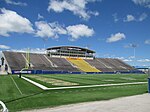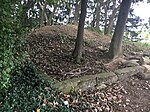Brady Lake, Ohio

Brady Lake is an unincorporated census-designated place and former village in Portage County, Ohio, United States. The population was 1,222 at the 2020 census. Incorporated in 1927, it originally developed as an amusement park and summer resort that opened in 1891. It was formed from a small portion of Franklin Township and became fully independent of the township in 1993. The village was named after the lake it borders, Brady Lake, which in turn was named for Captain Samuel Brady, who hid in the lake around 1780 while being pursued by a band of local Native Americans.Residents voted to dissolve the village on May 2, 2017, and the area was again made part of Franklin Township. In 2019, the United States Census Bureau created the Brady Lake census-designated place (CDP), an area that includes the entire former village as well as the immediate surrounding area. The CDP is part of the Akron metropolitan area.
Excerpt from the Wikipedia article Brady Lake, Ohio (License: CC BY-SA 3.0, Authors, Images).Brady Lake, Ohio
10th Street, Franklin Township
Geographical coordinates (GPS) Address Nearby Places Show on map
Geographical coordinates (GPS)
| Latitude | Longitude |
|---|---|
| N 41.163333333333 ° | E -81.312777777778 ° |
Address
10th Street
10th Street
44242 Franklin Township
Ohio, United States
Open on Google Maps





